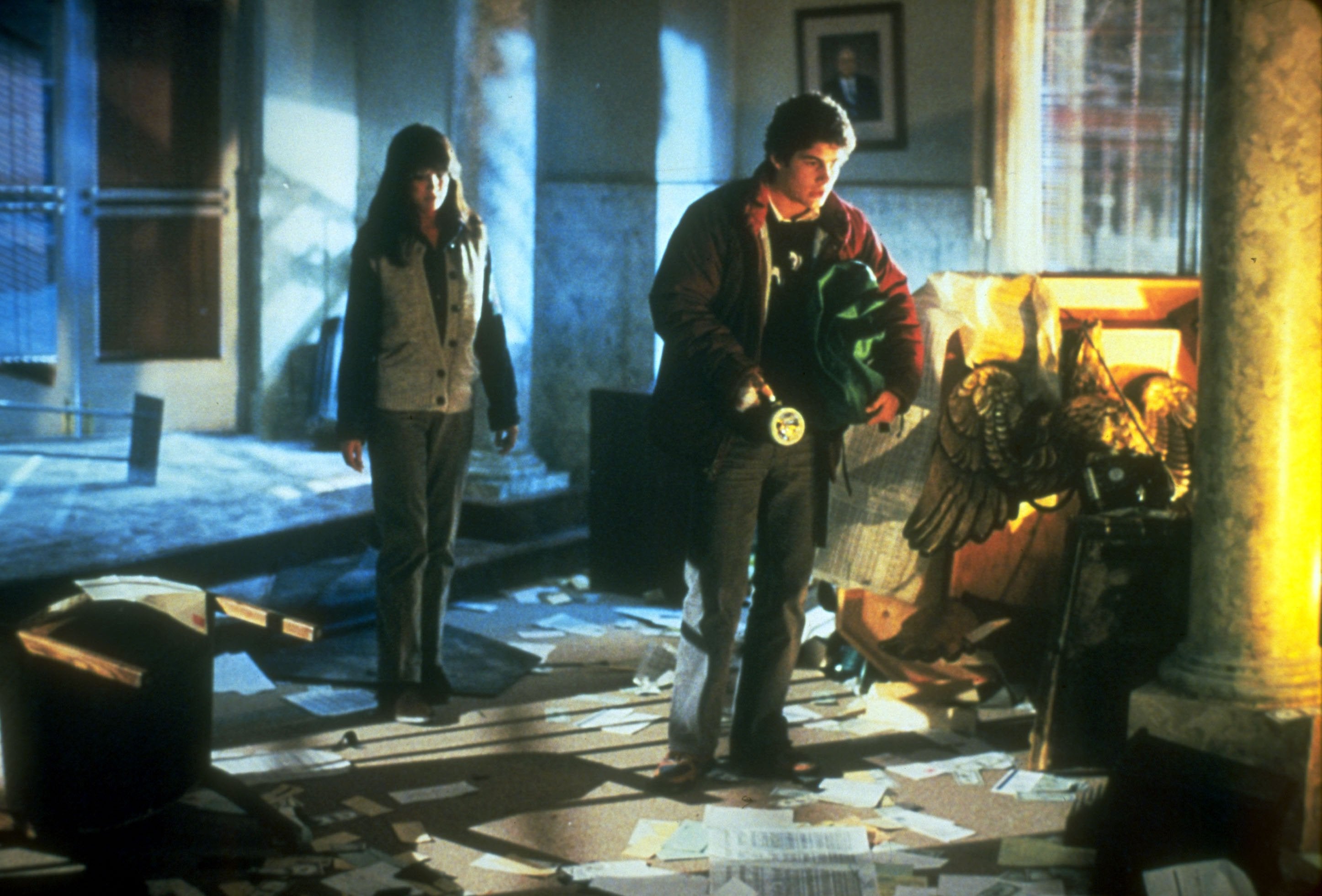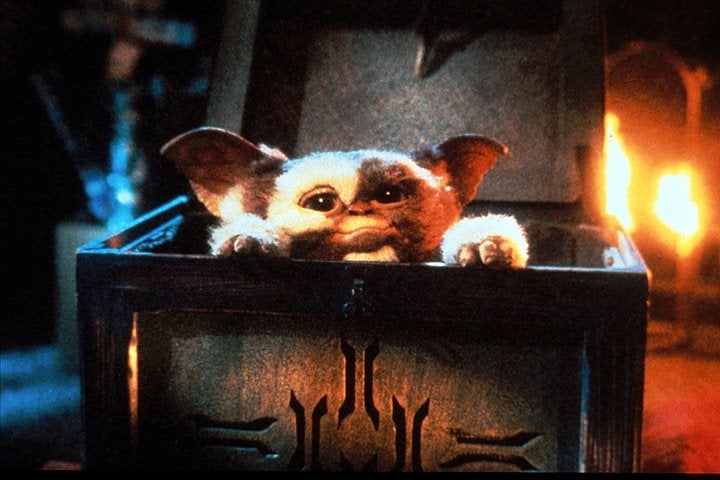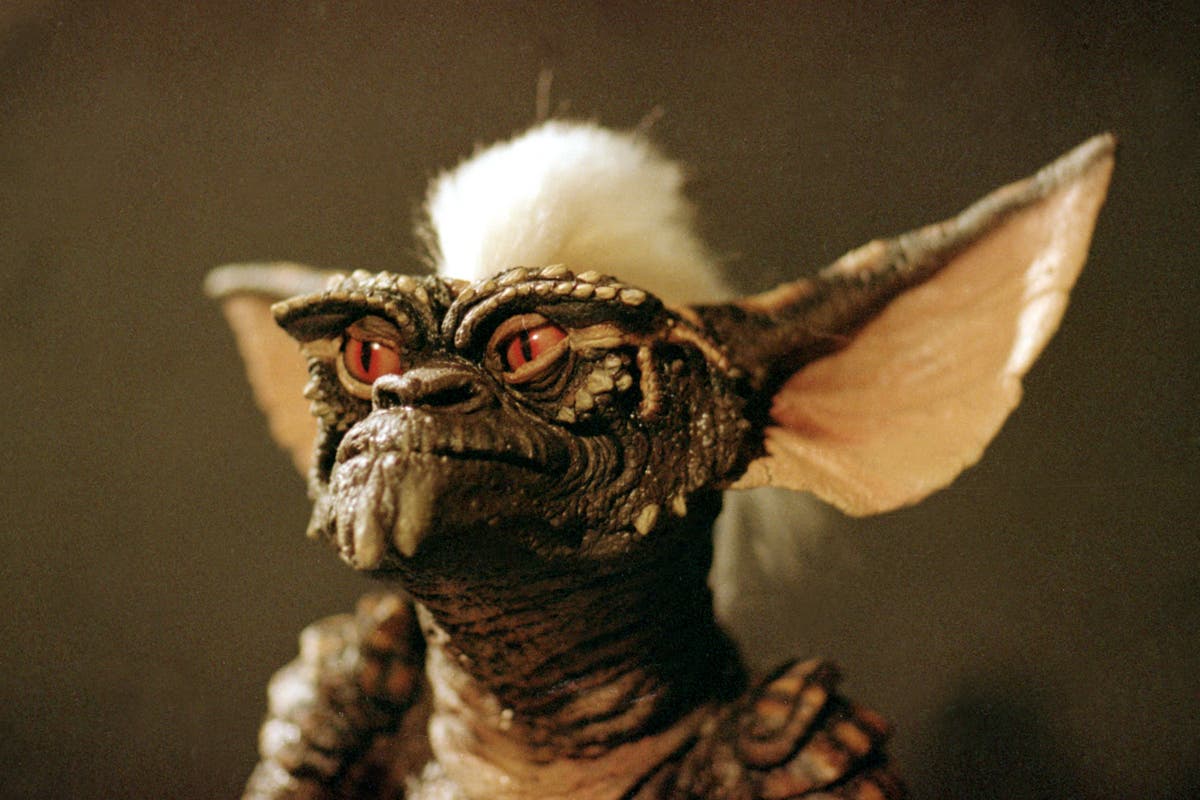Imagine being pursued by a great white shark around your living room. It’s never going to happen – but Joe Dante’s anti-Christmas comedy-horror Gremlins (1984), back on screen soon to mark its 40th anniversary, is as close as you get to Jaws without the ocean. Humans are preyed on by feral hordes of seemingly cuddly little animals. When the film’s young hero Billy (Zach Galligan) is given a “mogwai,” a furry creature who looks like a baby Yoda, as a seasonal gift, sheer bloody mayhem ensues.
One key reason Gremlins was such a runaway hit, and has inspired so many imitators (Critters, Ghoulies, and Munchies among them), is that it unleashed its pint-sized monsters into everyday American domestic life. This isn’t King Kong or Jurassic Park. It is not set in a jungle, a national park or during a deep sea dive. Some of the most dramatic scenes take place in the hero’s family kitchen, when Billy’s resourceful mother (Frances Lee McCain) forces an especially vicious gremlin into the microwave and splatters another in the food mixer.
Another reason for the film’s enduring popularity is its very double-edged depiction of the chihuahua-sized fiends. At times, director Dante actively encourages the audience to identify with these anarchic little varmints. They’re eerily human in their behaviour – but it’s humanity at its very worst. They gamble, slurp beer, guzzle popcorn and, late on in the movie, one of them, in a dirty Mackintosh, is even seen flashing. During the film’s most glorious and subversive scene, hundreds of the grotesque beasts are shown in a cinema singing along in ecstatic chorus to the “Hi Ho” anthem from Disney’s Snow White and the Seven Dwarfs.
Dante knew all about shock tactics. He made his reputation cutting trailers for exploitation maestro Roger Corman.“I owe it all to Caged Heat,” he later joked, referring to the teaser he put together for Jonathan Demme’s notorious 1974 women-behind-bars flick. That film, Dante’s trailer proclaimed in its mock-serious voiceover, was set in “a seething hell of steel and stone where bodies behind bars ache for a man… where caged passions ignite in carnal confinement and explode into violence”.
The director’s breakthrough feature Piranha (1978) was (by his own admission) a shameless “rip-off of Jaws,” albeit one greatly admired by that movie’s director, Steven Spielberg, who intervened when Universal tried to block its release.
“To my everlasting gratitude, Spielberg saw the movie and said ‘no, you guys don’t understand, it [Piranha] is a spoof. It’s a parody of Jaws, it’s not a rip-off.’ Well, that was very kind of him… because it really was a rip-off,” Dante said in a 2016 interview.
Dante was later attached to direct an even more outrageous skit on Spielberg’s shark classic. National Lampoon’s Jaws 3 People 0, co-scripted by John Hughes (soon to make The Breakfast Club and Ferris Bueller’s Day Off), ranks among the weirdest and most outrageous Hollywood projects of its era. Its story opened with the actual Jaws author Peter Benchley being eaten alive by a great white in his own swimming pool, but leaving behind him a script for Jaws 3. It included one scene in which the shark’s stomach is cut open. Out pops everything from a power mower to an Egyptian vase, a dead racoon, a violin and a bowl with a goldfish on it.
“The movie was about a movie company making a movie where it’s supposed to be a fake shark movie but it’s a real shark,” Dante explained in Dave Alexander’s book Untold Horror. Unsurprisingly, the project, due to star Bo Derek and Richard Dreyfuss, was harpooned by the studio bosses long before a foot of film had been shot. Dante went off to make his hit werewolf movie The Howling (1981), instead.
Traces of both Piranha and of the abandoned shark spoof eventually fed into Gremlins. It has the relentless feeding-frenzy feel of the former and the morbidly crazy humour of the latter. No one was quite sure what this was – a mainstream movie with violent, grungy B-horror ingredients festering inside it, or the reverse?
A deliberately creaky plot begins just before Christmas. Shambling salesman and inventor Randall Peltzer (played in a very avuncular fashion by country singer Hoyt Axton) ventures into Chinatown. He is trying to find buyers for his own strange contraptions while looking for a present for his kid. That’s how he ends up in a basement store where he gets hold of Gizmo, the adorable little “mogwai,” (voiced in gurgling baby tones by Howie Mandel). Rand is warned to keep Gizmo out of the light, away from water, and never, ever, under any circumstances, to feed him after midnight. Inevitably, the advice is disregarded and the creatures begin to multiply.

The idea of a Gremlins movie stretched back to the early 1940s when, long before his Willy Wonka glory days, young British ex-pilot Roald Dahl wrote a story, Gremlin Lore, about little imps with horns causing havoc for RAF planes. Walt Disney toyed with the idea of adapting it for the screen. The film project was scrapped but a children’s novel was published with accompanying illustrations from top Disney animators.
Four decades later, a youthful Chris Columbus (later to direct Home Alone and Harry Potter but then an unknown in his early 20s) came up with his own “spec” Gremlins script. Producer Mike Finnell later claimed it was sent out as an example of his writing talents but no one expected it actually to be made. It was too violent and gory for that, and, as Finnell told website The Ringer, “just too nuts.”
Steven Spielberg put his foot down and said, ‘You know, this Gizmo character, I like him too much. You have to keep him around’
Joe Dante
The script, though, somehow reached Spielberg. He had set up his own company Amblin Productions, and was looking for offbeat projects exactly like this. He had already worked with Dante on one of the segments of Twilight Zone: The Movie (1983) and sounded him out about taking on Gremlins.
The Spielberg factor was crucial to how the film eventually turned out. Left to his own devices, Dante would surely have made something yet darker. As its exec producer, Spielberg wasn’t calling the shots, but he influenced the film in important ways. The lovable Gizmo character, the one Gremlin who never turns to the dark side, was modelled after Spielberg’s pet dog.
“He [Spielberg] kept not approving the design and we said let’s make it the same colour as his dog and maybe he’ll approve it,” Dante told Gilbert Gottfried’s Amazing Colossal Podcast.
Spielberg also toned down the more bloodcurdling aspects of the screenplay. In the original version, Gizmo starts off cute and loveable but eventually transforms into Stripe, the nastiest, most psychotic gremlin of all.

“Steven Spielberg put his foot down about two weeks before we started shooting and said, ‘You know, this Gizmo character who turns into the bad Gremlin after 20 minutes, I like him too much. You have to keep him around for the whole movie,” Dante later said.
Almost everything about Gremlins is a little jarring. The film is set in a snow-covered small town but was very clearly shot on a Los Angeles studio set. Plot elements don’t always make much sense. For instance, the rule you must never feed the creatures after midnight doesn’t specify time zones.
When you see Billy’s dad buying Gizmo, you think the hero must be a 12-year-old kid, like the young protagonists of films like ET. In fact, Billy is already an adult with a job in the bank. After all, the movie’s most extreme scenes – for instance one of the rodents coming after Billy with a chainsaw – would have been unconscionable in a kids’ movie.
It is these sudden oscillations between family movie whimsy and pure unadulterated horror that make the movie so unique.
Jaws had Robert Shaw’s famous “Indianapolis” speech about sharks devouring US sailors in the water. Gremlins boasts an equally memorable monologue, delivered by the young female lead Phoebe Cates, in which she describes her father breaking his neck while climbing down the chimney dressed as Santa Claus. His body wasn’t discovered for several days despite the pungent smell. She has hated Christmas ever since – and it’s hard to blame her. The studio bosses were appalled at such a morbid scene which they tried hard to cut out but Spielberg again stood up for Dante – and so it stayed in.

Meanwhile, Dante, an ardent cinephile, kept the critics happy by filling the film with references to classic movies like Invasion of the Body Snatchers and It’s a Wonderful Life. He also included some frenetic moments of Keystone Cops-style slapstick, perhaps most notably the scene when the nasty, Scrooge-like Mrs Deagle (Polly Holliday) is propelled at breakneck speed out of her own window on her chair lift.
Gremlins, then, had something for every audience. Long before the term was coined, it was the perfect “four quadrant” movie, appealing to men and women, young and old. Most films that fit that description today are sanitised and bland. Gremlins, though, was perverse in the extreme. Its secret power was its willingness to startle and offend its viewers – something they enjoyed far more than the nervous Hollywood execs financing it could ever have anticipated.
Censors, though, were flabbergasted. In the UK, the BBFC (The British Board of Film Classification) quickly slapped a 15 certificate on the film, keeping it firmly out of the reach of children. In the US, where it was released as a PG, the controversy around such a violent and transgressive movie being accessible to kids led to the creation of a brand new certificate, the PG-13.
Gremlins, then, wasn’t only fun – it was groundbreaking. The sequel Gremlins 2: The New Batch (1990) was even weirder, and notably added a character directly spoofing a pre-presidential Donald Trump. When it comes to disobedient monsters causing outrage throughout polite society, however, the original Gremlins has plenty enough.
‘Gremlins’ is back in UK cinemas on 6 Dec, now with a 12A certificate

